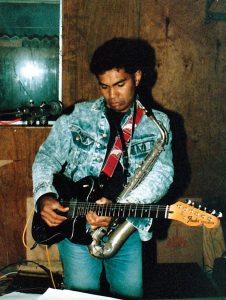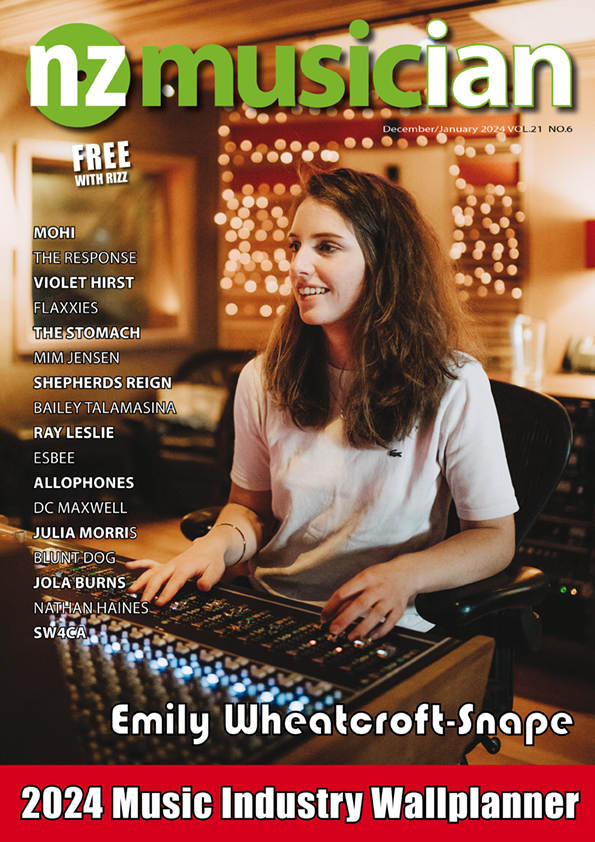Fragile Colours: Tickled Pink
Fragile Colours: Tickled Pink
With a few more radio hits it could be the album story of the century – well two centuries actually, given that it was started back in 1987. Having recorded the demo tracks for an artful concept album, musician/producer Tim Julian consigned the project to a bottom drawer for over a decade. Having blown the dust off he then spent a further decade-plus developing and refining the ideas, enlisting musicians and massaging tracks into, perhaps, his own magnum opus. Sammy Jay Dawson investigated the background to ‘Southern Utopia’.
To call Fragile Colours‘ recently-released album ‘Southern Utopia’ a labour of love is somewhat of an understatement. In the decades since its inception in 1987, its creator Tim Julian has slowly pieced his magnum opus together, at the same time establishing and running his own provincial studio (Colour Field) and record label (Fragile Colours Music). Beginning life as an ambitious project amongst friends, little could anyone imagine the resulting album might possibly be released 28 years later.
“Essentially the first ideas for ‘Southern Utopia’ and Fragile Colours all started in 1987,” Julian recalls. “I’d just left school and got stuck into a band with a friend, Fred Renata. We just sort of clicked and did a bit of writing together. It didn’t take long before we had this huge concept idea for an album – which may or may have not in its first stages, been a bit ambitious.”
 The shoulder shrug and wry smile is implicit.
The shoulder shrug and wry smile is implicit.
Fred Renata has since built a huge reputation as being one of the country’s most distinguished Maori cinematographers, going on to direct photography across all spectrum of media including music videos, commercials, television drama, documentaries and feature films. Now the owner of Tinopai Films, his recent work has included the Mt Zion movie as well as an array of Maori theme documentaries including Street Legal, Raising The Moko and He Wawata Whaea.
“A dream is just a dream on your own, but when we dream together, things happen,” he is quoted on the album’s liner notes.
What has surfaced in 2015 was originally planned to be a concept album documenting New Zealand’’s place in the world and it’s relationship between it’s people and the land. Renata handled the lion’’s share of the lyric writing, using his heritage as just one of many viewpoints on the subject. Julian readily admits to awkwardness at it having been almost three decades in the making.
“It’’s almost embarrassing how long it’’s taken, but I guess I was young and green,” he admits laughing. “We recorded all the initial demos at Fred’’s house, which looking back were a bit rough. We had the recording set-up in the dining room, on the same table that Fred ate breakfast on, and the live room was in the lounge with some French doors in-between.
“Fred had just made his first forays into feature film by this stage, so we wrote a letter to the Arts Council proposing that we have the album as the backdrop for a feature film. All up we weren’’t asking for much, just a million dollars! We typed it all up very nicely, but never got a reply… We thought, ‘We’ll ask for loads, that way they’ll know we’re confident we can make it back.’ That was pretty bold!”
With lush textures, catchy hooks and proggy leanings, it’s an expansive listen. Often bringing to mind Peter Gabriel or Pink Floyd, messages are weighted skillfully with the music’s art.
“The name ‘Fragile Colours’ reinforces a few ideas, for example the idea that colours are fragile. If you’re down getting your pot of paint filled at Mitre 10 and they accidentally put an extra couple of drops of another colour in, you see how fragile colour really is – it changes. So I think that, with most things artistic there’s fragility attached.
“After the original writing and recording period, we took a bit of a break from things due to a various family circumstances and life changes, so everything just got shelved. What started as this great idea for an album just became a cassette tape, in a self-addressed envelope. There was a blue folder along with a whole heap of notes and a letter to the Arts Council, and it just sat in the bottom draw for years gathering dust.”
Moving to Welcome Bay, Tauranga in the late ’90s, Julian opened his own Colour Field Studio, and eventually found time to revisit those demos for ‘Southern Utopia’. Inevitably most of his time has since been spent recording other acts, but over a period of year the songs were developed to the stage of bringing in outside musicians – who now make up Fragile Colours.
“There’s a bit of an all-rounder cast playing on ‘Southern Utopia’, Julian explains. “Sean Bodley, did a lot of the guitar work on the record. He releases a lot of solo guitar albums, most recently ‘Pitch Black’, just a few months back. His arrangements and melodies are always a notch above where he was when I’ve last heard him.”
Julian himself plays bass and keys and is the album’s vocalist. It could hardly be described as a guitar album, but more guitar tracks were provided by Marion Arts, Bruce Rolands, Steve Bennett and Trevor Collings who used to work with Ardijah.
“His guitar playing is a lot more muscular than Steve’s. Steve is a real shred guy, very precise, very into Steve Vai and Joe Satriani, amazing player but two complete different styles. Brilleaux guitarist Bruce Rolands also contributed because we wanted to get that raw rock’n’roll energy, which Bruce just oozes.
“I met drummer Jed Dawkins while recording an album for X-Factor finalist Leilani Taula, who I used to teach piano. We ended up getting Jed in to do a couple of tracks. After one take I knew that I’d found the drummer for Southern Utopia, he’s just a monster.
“I did all the vocals. I’m not a natural singer and there were a lot of things I wasn’t happy with, so I had to go through and correct a lot digitally. It was nasty,” he laughs.
“There was a young girl, Kamaea Harry, who did backing vocals on Leilani Taula’s album, that I got in for backing vocals. Her voice is a nice contrast to mine – she’ll be doing the lead on the next Fragile Colours’ album instead! I recorded all the bass myself. I tried to reference players like Dee Murray who played on Elton John’s early records, and of course Geddy Lee from Rush. I wanted the drums and the bass to be really tight at the bottom end, have that classic rhythm section sound.”
From the synth-driven Hearts Behind A Wall, to the Dire Straits-esque Broken Promises, Julian’s rich production holds the entire project together. Paying homage to the era of the ’70s concept LP, ‘Southern Utopia’ is much more than the sum of its parts, drawing an overall strength from its continuity and (now quarter-century old) lyrical themes.
“Fred wrote all the words. The concept and theme of the album looks at New Zealand’s place in the world. How we relate, how we deal with things and all kinds of events that have affected us. We were one of the last countries to be found and populated, and we still have very strong ties to all parts of our backgrounds.
“For example, there’s a line in the song, New Southampton, where Fred discusses his ancestors coming over from England but also being part Maori. ‘A reflection in the mirror, I see my mother’s face. A reflection in the mirror, I see another race.’ We’re a unique wee country. We do have a world-view that’s very different from the rest of the world, maybe it’s because we’re still such a young country or maybe it’’s because we have a very ‘observer’ stance.”
After the record was mixed and mastered Julian finally caught sent Renata a CD copy.
“He was gob-smacked. The end result turned out quite different to the original demos, but the vision was the same.”
Julian hopes ‘Southern Utopia’ will prove to be the first of many future Fragile Colour releases, and promises a follow up sometime before 2043.
“We’ve had a lot of people say, ‘What are you doing guys? This is great, why did you wait so long?’ But it wouldn’t have turned out that way unless we had waited. This is just how it rolled. It is what it is because of the process.
“I guess if you take anything from our experience, if you have something you think is good, stay on it, don’t give up on it, and do it. Even if it takes 28 years… Try not to let it, but keep at it.”
